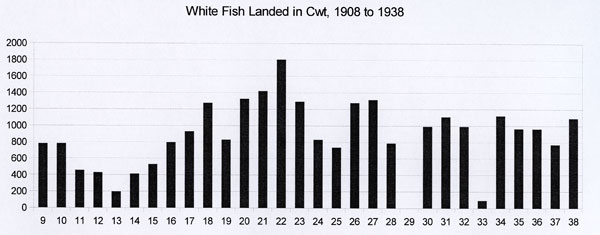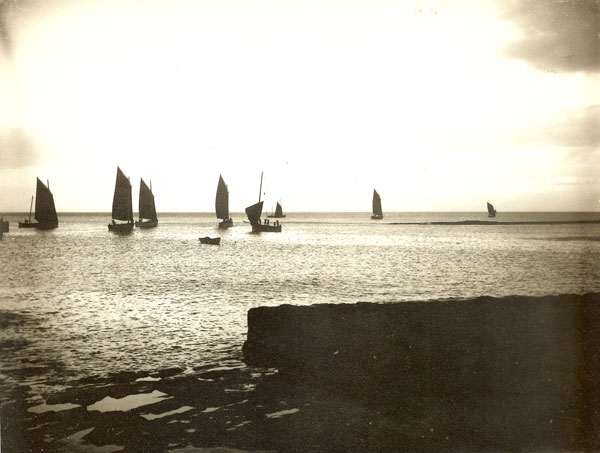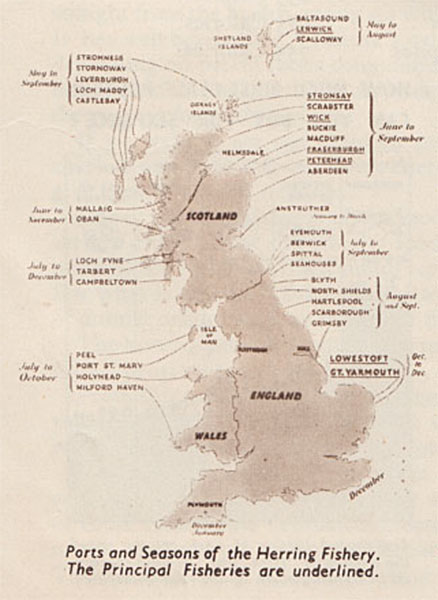 |
|
Archway - Tower Bank |
Fishing from Craster |
|
In "Ports and Harbours of Northumberland", Stafford Linsley wrote, "Craster is known to have supported eight resident fishermen in 1626 and it is reasonable to suppose that fishing remained its economic mainstay for some centuries after that."
The village is strongly associated with the production of kippers, but over the centuries Craster fishermen have fished for white fish, salmon and crab & lobster. Fishing for herring ceased many years ago and the principal catch of Craster's remaining fishing boat is now shell fish.
The harbour account book, with annual accounts from 1908 to 1938, which is part of the County Collection at Woodhorn, is an invaluable source of information about the activity in the harbour. Extracts from this book have been transcribed and can be downloaded from here.
The spreadsheet was written in Open Office, which can be downloaded free of charge from Open Office.
Data from the account book has been used to create the following bar charts that show the activity in Craster Harbour during this period. The accounting period used in the book began on April 1st and ended on March 31st; the dates in the charts refer to the end of the accounting period. Therefore, taking the figures for 1916 as an example, the activity recorded took place from April 1st 1915 and ended on March 31st 1916.
The account book has nothing to say of course about any product that was transported by road.
The accounts for the landing of herring, white fish and shellfish are not kept in a consistent way during the period covered by the account book. This has implications for the transcribed records, but the qualifications to the data that are necessary, which do not significantly affect the general picture, are not covered here, but they are in the transcription that can be downloaded.
The chart for herring landed shows significant change over the period. A peak in 1910 is followed by a marked decline in the period before and during WW1. It is perhaps no coincidence that the low of 1916 took place after the German Navy's attacks along the east coast (e.g. on Scarborough in December 1914) and in the period of great tension in the North Sea, which came to a head in the battle of the Dogger Bank in January 1915 and continued until the battle of Jutland May 31st/June 1st 1916. The following twenty years shows landings to be variable, rising to their highest levels in the late 20's, but general activity significantly below the pre-war level, particularly during the last five years before the account book finishes.
 |
This compares with national production figures from The Herring Industry Board, (Lecture Notes on the Herring).
Average Annual Weight Landed in Cwts. |
Average Annual Value in £ |
|
1911 - 1913 |
10,800,000 |
3,700,000 |
The landing of white fish shows cyclical change during the period, rising from a low in 1913 during WW1, a peak in 1922, followed by a decline to 1925 and then a revival in 1926/27. Activity from 1928 to 38 varied between 800 and 1100 cwt, except in 1929 and 1933.
 |
In the run up to WW1 the landing of crab and lobster was highest in 1909 and then rose gently from a lower level in 1910 upto the outbreak of the war. From 1915 activity was generally lower, with isolated highs in 1923 and 1928. In the 30's the annual catch was typically at a new lower level.
 |
The harbour accounts show a surprising and perhaps unexpected pattern of activity in the export of salt herring. It is possible that this trade was rather bigger and more consistently undertaken than shown in the harbour accounts, but was carried out by road. There is no other data currently available to improve our understanding of this aspect of Craster's trade.
 |
A more detailed look at the accounts reveals that herring was landed in Craster between, and including, the months of May and September. Given the accounting period explained above, the bar chart shows the herring landed in one year as being landed in the following year! Taking 1916 again as an example, the 163 barrels of herring were actually landed between May and September of 1915.
The seasonal nature of herring fishing is manifest in the following map from The Herring Industry Board:
|
It is repeated in this table - The Fishing Season - from the same source.
 |
Home Programme Membership Archive War Memorials History Walk Miscellanea Links Contact Us
 Source: Ann Kelly
Source: Ann Kelly